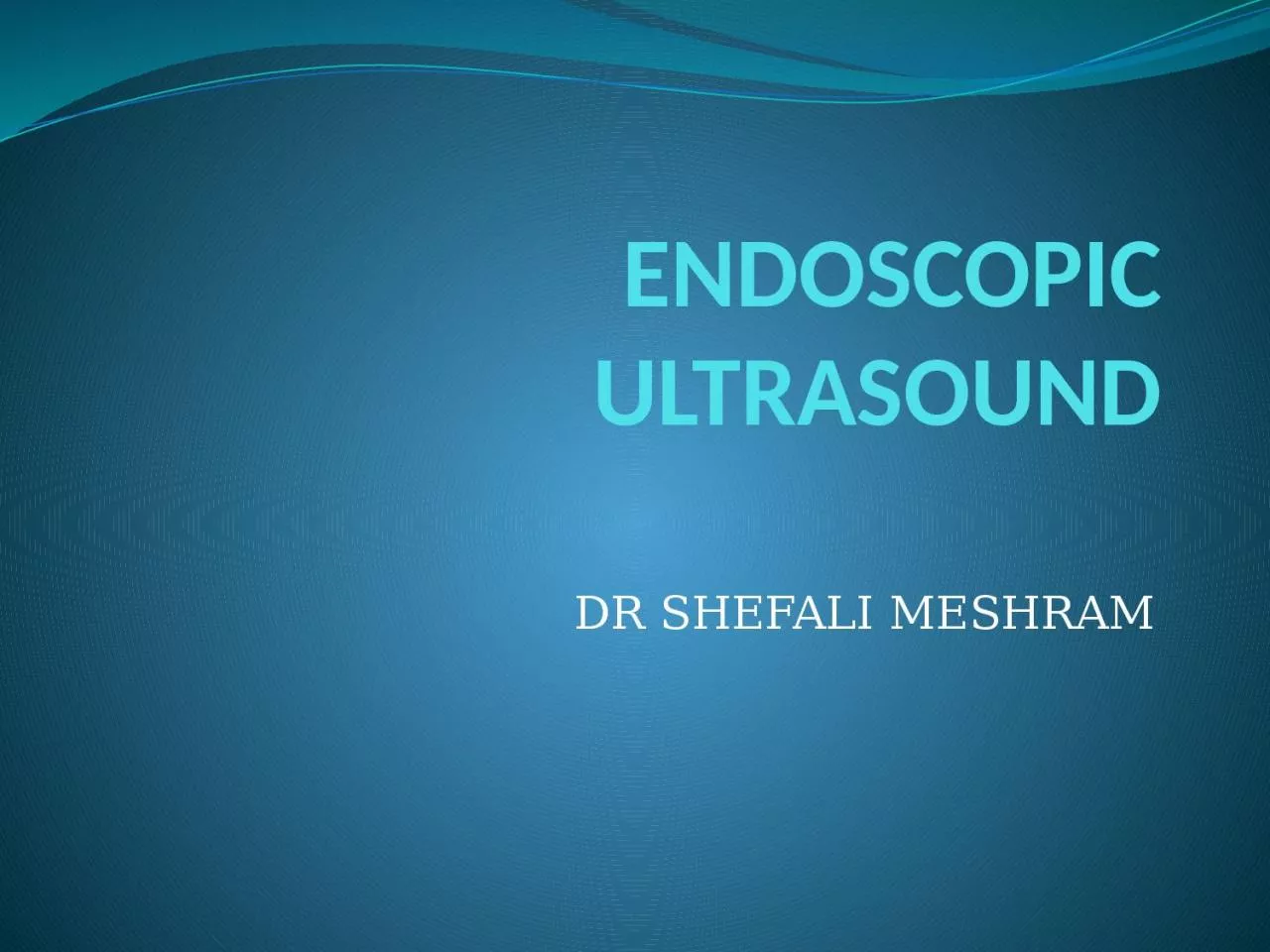

Endoscopic ultrasonography EUS employs the technology of endoscopy and internally placed highfrequency ultrasound waves to visualize the gastrointestinal wall and adjacent structures EUS has emerged as an important modality for the diagnosis and staging of benign and malignant lesions of t ID: 917177
Download Presentation The PPT/PDF document "ENDOSCOPIC ULTRASOUND DR SHEFALI MESHRAM" is the property of its rightful owner. Permission is granted to download and print the materials on this web site for personal, non-commercial use only, and to display it on your personal computer provided you do not modify the materials and that you retain all copyright notices contained in the materials. By downloading content from our website, you accept the terms of this agreement.
Slide1
ENDOSCOPIC ULTRASOUND
DR SHEFALI MESHRAM
Slide2Endoscopic
ultrasonography
(EUS) employs the technology of endoscopy and internally placed high-frequency ultrasound waves to visualize the gastrointestinal wall and adjacent structures.
EUS has emerged as an important modality for the diagnosis and staging of benign and malignant lesions of the gut wall and surrounding structures of the
mediastinum
, abdomen, and pelvis.
Slide3INDICATIONS:
Staging of Ca esophagus, Stomach and Rectum.
Evaluation of abnormalities of GI wall or adjacent structures (
submucosal
masses, extrinsic compression)
Evaluation of thickened gastric folds.
Diagnosis (FNAC) and staging of Ca pancreas.
Evaluation of pancreatic abnormalities ( suspected masses, cystic lesions including
pseudocysts
, suspected chronic pancreatitis).
Staging
ampullary
neoplasms
.
Diagnosis and staging of
cholangeocarcinoma
.
Evaluation of suspected
choledocholithiasis
.
Celiac plexus
neurolysis
for chronic pain due to
intraabdominal
malignancy or chronic pancreatitis.
Diagnosis of Ca lung and its staging.
Slide4Two types of
echoendoscopes
are generally used in studying the gastrointestinal tract.
One
is a 360° radial scanner
(
eg
, Olympus UM20, UM30
Echoendoscopes
),
The
other, a sector scanner (
eg
, Olympus UC30P,
Pentax
FG32UA
Echoendoscopes
).
Slide5Slide6The radial scanner produces a 360° view perpendicular to the shaft of the endoscope and has the option of scanning at 12 or 7.5 MHz . The higher frequency scanning (12 MHz) allows for better visualization of details at close range. The lower the frequency, the better the penetration of ultrasound waves; thus, at 7.5 MHz, the scanning range
increases over 12
MHz.
The radial
echoendoscope
is preferred by many
endosonographers
because it gives a 360°overview, similar to a computer tomogram, allowing complete visualization of the gastrointestinal tract and its adjacent
structures.
Slide7Slide8The sector scanners are preferred for use in EUSFNA because they allow direct visualization of the needle up to 5-6 cm parallel to the shaft of the endoscope.
The radial scanner is difficult to use for FNA because the tip of the needle quickly leaves the scanning area, which is perpendicular to the tip of the endoscope
Slide9Slide10A
waterfilled
balloon
over
the transducer allows close contact of the transducer to suspected lesions in the gastrointestinal wall or
adjacent structures.
For the evaluation of lesions located in the stomach wall, filling the stomach with
200-500mL
of water
often allows
for detailed images of the gastric wall structures.
Slide11In addition,
highfrequency
ultrasound probes that are passed through the biopsy channel of an endoscope are available.
Catheterbased
ultrasound probes that employ
highfrequency
ultrasound (20
mHz
) may be used through traditional
videoendoscopes
. These
highfrequency
ultrasound probes (HFUPs) are useful in evaluating small mucosal/
submucosal
lesions in the luminal gastrointestinal tract.
Slide12PREPARATION.
Preparation of the patient is same as that for conventional endoscopy.
NBM for 8 hrs.
Medications such as Aspirin or any other blood thinners are usually stopped 5-7 days prior to the procedure.
For lower GI
scopy
, the colon should be free of any
faecal
matters. For that laxatives are given 1 day prior to the procedure. Patient is kept on liquid diet and enema may be required prior to the procedure.
All the risks of the procedure are explained to the patient and written informed consent is taken.
It is usually done under conscious sedation and the
procedure takes almost 1 hr. Patient is usually kept under
observation for 1 hr.
Slide13POSITION
Slide14RISKS
Upper GI endoscopy (EGD): Although rare, bleeding and puncture of your esophagus or stomach walls are possible during EGD. Other complications include the following:
Severe irregular heartbeat
Pulmonary aspiration - When material, either particulate (food, foreign body) or fluid (gastric contents, blood, or saliva), enters from your throat into your windpipe
Infections and fever that wax and wane.
Respiratory depression, a decrease in the rate or depth of breathing, in people with severe lung diseases or liver cirrhosis
Reaction of the
vagus
nerve system to the sedatives
Slide15RISKS
Lower GI endoscopy (colonoscopy,
sigmoidoscopy
,
enteroscopy
): Although uncommon, possible complications of colonoscopy and
sigmoidoscopy
include the following:
Local pain
Dehydration (due to excess of laxatives and enemas for bowel preparation)
Cardiac arrhythmias
Bleeding and infection
Respiratory depression usually due to
oversedation
in people with chronic lung disease
Slide16EUS is more difficult than
conventional endoscopy
, because the EUS endoscope has a
forward oblique or
sideviewing
and
also because the rigid portion of the
endoscope tip
is longer than it is on conventional upper endoscopes. This design increases the risk of perforation, especially if
the instrument
is advanced from the stomach into the descending duodenum. Experience in
transabdominal
ultrasound
is helpful
in this setting because it introduces the examiner to the
echostructures
located in
the abdomen
, such as
the liver
, spleen, pancreas, kidneys, and
intraabdominal
vessels.
In many
institution,
transabdominal
ultrasound is
routinely performed
prior to EUS to obtain an overview
.
Slide17EUS can detect lesions as small as
2-3 mm
in size and is the best method for determining the 5
echogenic
layers
of the
stomach. The 5 layers are
histologically
correlated with the mucosa (layer 1), deep mucosa (layer 2),
submucosa
(layer
3),
muscularis
propria
(layer 4), and
serosa
or adventitia (layer
5)
Slide18Slide19Slide20Slide21Slide22Slide23Slide24Slide25Slide26Slide27Slide28Slide29Slide30Slide31Slide32Slide33Slide34Slide35Slide36THANK YOU.